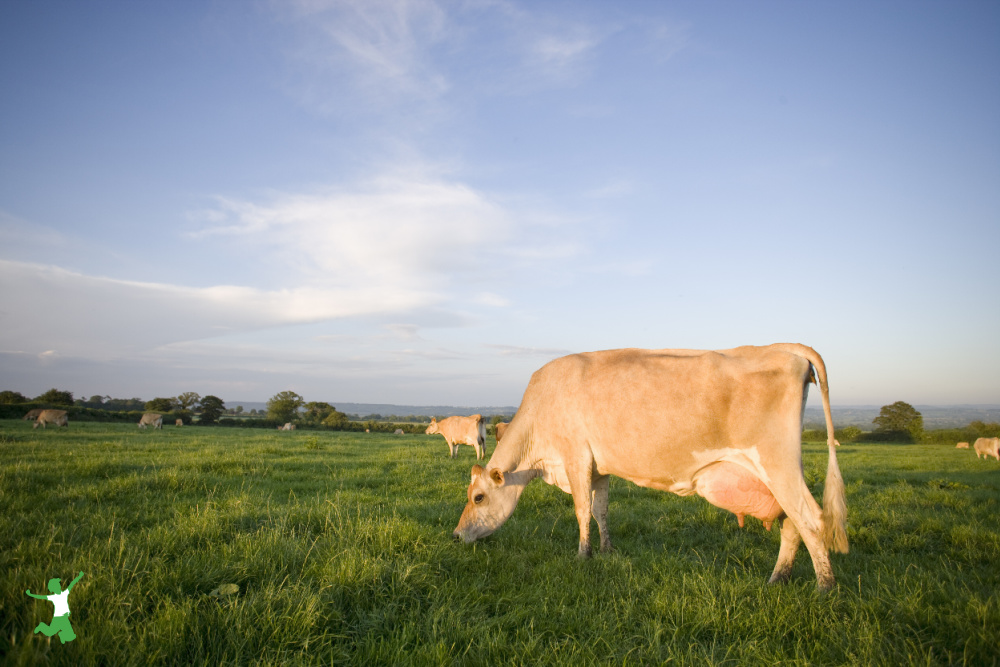Table of Contents[Hide][Show]
Why fully pastured cows are often healthiest and produce the best and safest milk with the lowest somatic cell count when a small grain ration is provided during milking rather than “100% grassfed”.

The dairy cows we see nowadays are not the same cows we see in old pictures from the 1930s.
The cows in those pictures were high-producing beef cows.
They have been selected for higher production and the self-preservation mechanism to drop that production when feed is unbalanced (i.e., too much grain OR too much grass/hay), has been bred out of them.
Cows are fermentation vats which means they depend on microbes and beneficial bacteria to digest forage and break down forage in their gut.
This digestive fermentation allows a cow to absorb the nutrients and produce milk and meat as well as calves and breed back (get pregnant).
Microbes and beneficial bacteria need starch (energy) to multiply to digest large amounts of protein or too much lignin.
Too much protein comes from too much short grass or too high protein hay.
Lignin comes from too-mature hay, or too-tall pasture.
Can Pastured Cows Get Too Much Grass?
Does this mean a cow can actually get too much grass or hay?
Yes, it does.
Cows on too much protein (short grass with very little energy) drown the microbes in their guts resulting in very little forage being digested and utilized.
This can result in a situation where the cow is more prone to mastitis which may go undetected. Low-grade infection can trigger somatic cell counts in the milk to rise, a risk to consumer health.
This situation can also create high nitrogen (urea) in the bloodstream. The results are a negative effect on body weight, milk production, milk quality, and breedability because the cows are actually starving even though they constantly eat.
Cows on too much old hay do not have the energy to digest the woody fiber of the hay and end up losing weight and/or reduced milk production and do not breed back because, once again, they are starving even though they constantly eat.
Cows only take so many mouthfuls a day, give or take a few minutes.
They meet their needs or lose body weight, and/or milk until they die prematurely.
Forms of Starch
Balanced grass can have starch, and proper protein levels to match that starch, but that only happens on grass for a very short period (hours), unless one can control water and height.
But….
Most cannot.
So starch (energy) must be supplied to the cow in a form of grain, in an appropriate amount to meet the energy needs of the cow given the other forage she is eating.
A good dairyman knows this and will not withhold the grain when it is necessary for the cow’s health.
The more balanced the forage and grass she is eating the less grain she needs and the more nutrient dense the milk is.
However our soils are very much out of balance, so incomplete proteins are made which go into the blood stream quicker if microbes and beneficial bacteria are not in sufficient number to utilize the protein.
Small Amounts of Grain Compensate for Soil
So, grain has been fed to make up for the lack of soil mineralization and balanced forage as well as to meet a milking cow’s energy needs.
Soil has been degraded to the point that farmers have problems holding on to the right amount of energy-to-protein ratios in our pasture.
Cows cannot travel to maintain the balance of energy to protein (new grazing grounds) as their Bison cousins did.
Humans are servants to cows until the consumer and producers reestablish the soil and forage balance.
The grain versus grass debate is not black and white.
Both are a valuable part of a cow’s diet but not a complete diet in and of themselves.
The principles of the cow are what they are.
It is not fair or wise to put the burden of unrealistic consumer choices on an animal or a farmer in an unsustainable way.








The Great Grass Versus Grain Debate – The Healthy Home Economist http://t.co/X4KFO6aE